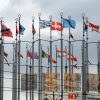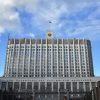Neo Nazis, Alt-Right, and White Supremacists encircle and chant at counter protesters at the base of a statue of Thomas Jefferson after marching through the University of Virginia campus with torches in Charlottesville
Credit: Getty
A five-time Olympic swimming medalist, a stay-at-home dad, an army psyops officer and an unemployed “shaman” who lives in his mother’s basement — a motley crew of individuals who do not immediately appear to have much in common.
But a shared, extreme ideology had brought them together at the US Capitol in Washington on January 6.
It was the day that a far-right fervour which had been fermenting for years in America spilled out into the open, in one of the ugliest episodes in the country’s recent history.
The Telegraph spent the past week reviewing the dozens of criminal charges filed against those accused in the riot and speaking to their friends and family members to understand just how the more extremist fringes of US society became mainstream.
The mob was an unlikely melee of highly educated graduates, accomplished athletes, veterans and high school dropouts. Some had harboured far-right links through adulthood, others had turned to it in recent years.
The views expressed by those indicted over last Wednesday’s insurrection — laid bare in court for the first time — show sympathies to far-right causes and in many cases clear links to white extremist groups and militias.
Supporters of US President Donald Trump, including member of the QAnon conspiracy group Jake Angeli enter the US Capitol on January 6, 2021, in Washington, DC.
Credit: AFP
Ashli Babbitt, who was shot dead by a Capitol Police officer as she tried to storm Congress on January 6, had been a dedicated follower of QAnon, a wild conspiracy theory that claims the president is defending the world against a Satan-worshipping paedophile cabal masterminded by Democrats.
“She was not casual about it, she was deep into it,” one friend of Ms Babbitt, an Air Force veteran from California, told The Telegraph.
“She didn’t used to be this angry, but a few years ago she started following these theories online and made friends there,” said the friend, who asked not to be named.
Ashli Babbit
Her online accounts show she had voted Democrat in the past and praised former President Barack Obama as recently as 2018. But as her professional life collapsed — she left the Air Force and her small pool-service business was struggling — she became more obsessed with baseless online propaganda and ever more devoted to Mr Trump.
In the week leading up to her trip to Washington last week, friends noticed her fury had turned into excitement about a new mission — to bring down the Capitol.
Olympic gold medalist Klete Keller’s now-deleted social media feeds were filled with Donald Trump-conspiratorial rabbit holes. The 38-year-old, who had spoken on his accounts of his divorce and a period of homelessness, posted messages urging "patriots" to speak out about the "stolen election".
Five-time Olympic swimming medalist Klete Keller was charged Wednesday, Jan. 13, 2021 with participating in a deadly riot at the U.S. Capitol
Credit: AP
Keller struggled acutely to adapt to life after swimming. “Within a matter of a few years, I went from Olympic gold medalist to husband, homeowner, guy with a series of sales jobs — life insurance, software, medical devices, financial products — and father of three, and I had a really difficult time accepting who I was without swimming in my life,” he told NBC a few years back.
“He was lost,” said Rowdy Gaines, a three-time gold medalist and friend of Keller’s. “Sometimes when you get lost, you become a follower instead of a leader,” Mr Gaines said of Keller’s apparent devotion to Mr Trump. Keller could Not be reached for comment.
The court documents also reveal a convergence of QAnon, the far-right and white supremacy.
Richard “Bigo” Barnett from Arkansas, a Trump supporter and self-described “white nationalist”, was photographed sitting in House Speaker Nancy Pelosi’s office, his left foot propped up on a desk:
Credit: JIM LO SCALZO/EPA-EFE/Shutterstock
The Saturday before the riot, Barrett, a 60-year-old former firefighter, had criticised Ms Pelosi in a Facebook post for using the description “white nationalist” as a “derogatory term.”
“I am white. There is no denying that. I am a nationalist. I put my nation first. So that makes me a white nationalist,” Barnett wrote on his account before adding that people who were not nationalists should “get the f— out of our nation.”
In October, Barnett helped raise more than $1,000 for #SaveOurChildren, an anti-child-trafficking campaign. Facebook limited the use of the national campaign’s hashtag because it found that content tied to the campaign was associated with QAnon.
Barnett, who appeared in court earlier this week, could not immediately be reached for comment.
Many of the seemingly disparate individuals had communicated in online forums in the days leading up to the storming of the Capitol, joining forces last week in a dizzying alliance.
The Army is investigating Emily Rainey, a psychological operations officer, who led a group of people from North Carolina to the rally in Washington
Credit: AP
The leaders of several of these groups have been pictured over the last few years with people close to the president, including Rudy Giuliani, Mr Trump’s personal lawyer, and Roger Stone, his former political strategist.
Algorithms on social networks like Facebook “amplified the likelihood of a collision with far-Right and QAnon content and communities,” offered Shannon Foley-Martinez, a self-described former white supremacist who now works at the Polarization and Extremism Research Lab.
“It offers an explanation, validated by others, for why they have felt afraid, under threat, and separated from power they believe is rightfully theirs," she told The Telegraph.
Many retreated even further into these online communities after losing jobs and facing isolation in the real world due to the coronavirus.
“We have long held a stereotype that the far-Right is white, rural and uneducated. That’s no longer the case,” said Colin Clarke, head of research at the Soufan Center.
Mr Trump, the presidential candidate these groups chose to champion, has played a key role in making white nationalist ideas part of the national conversation.
“The movement has diversified geographically, it has diversified demographically and socioeconomically,” said Mr Clarke.
“You have an increasing number of educated and urban people sharing these opinions. The internet has allowed people who wouldn’t normally cross paths to converge online.”
Mr Clarke, who used to study Islamist extemism, sees similarities in the “radicalisation” of the far-Right with that of jihadists.
“The profile of the far-Right rioter and that of the foreign fighters are not all that different,” he told The Telegraph. “They are looking for brotherhood, a place to belong, a way to elevate their otherwise very ordinary lives.”
Like many analysts in the field, Mr Clarke has in the last year shifted his focus from Islamist extremism to the far-Right, as the FBI declared the greatest domestic terrorist threat in America today was from the far-Right.
According to the Center for Strategic and International Studies analysis, right-wing extremists perpetrated two-thirds of the attacks and plots in the US in 2019, and more than 90 per cent between January and May, 2020.
A recent poll found that eight per cent of Americans supported the attack on the Capitol.
Mr Clarke does not believe the threat from the far-Right will go away overnight.
“Eight per cent? That might not sound like a lot but that’s millions and millions of people,” he said. “We’re in for a world of trouble."























































Свежие комментарии